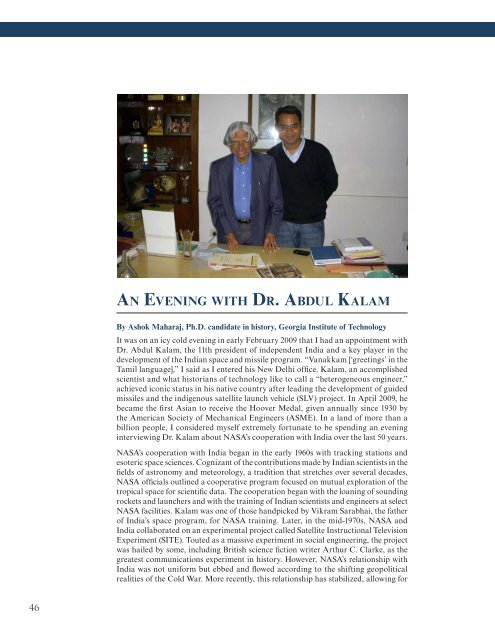FROM THE CHIEF HISTORIAN BORIS CHERTOK'S Rockets and ...
FROM THE CHIEF HISTORIAN BORIS CHERTOK'S Rockets and ...
FROM THE CHIEF HISTORIAN BORIS CHERTOK'S Rockets and ...
You also want an ePaper? Increase the reach of your titles
YUMPU automatically turns print PDFs into web optimized ePapers that Google loves.
nasa history division<br />
46<br />
an evening with dr. aBdul kalam<br />
By Ashok Maharaj, Ph.D. c<strong>and</strong>idate in history, Georgia Institute of Technology<br />
It was on an icy cold evening in early February 2009 that I had an appointment with<br />
Dr. Abdul Kalam, the 11th president of independent India <strong>and</strong> a key player in the<br />
development of the Indian space <strong>and</strong> missile program. “Vanakkam [‘greetings’ in the<br />
Tamil language],” I said as I entered his New Delhi offce. Kalam, an accomplished<br />
scientist <strong>and</strong> what historians of technology like to call a “heterogeneous engineer,”<br />
achieved iconic status in his native country after leading the development of guided<br />
missiles <strong>and</strong> the indigenous satellite launch vehicle (SLV) project. In April 2009, he<br />
became the frst Asian to receive the Hoover Medal, given annually since 1930 by<br />
the American Society of Mechanical Engineers (ASME). In a l<strong>and</strong> of more than a<br />
billion people, I considered myself extremely fortunate to be spending an evening<br />
interviewing Dr. Kalam about NASA’s cooperation with India over the last 50 years.<br />
NASA’s cooperation with India began in the early 1960s with tracking stations <strong>and</strong><br />
esoteric space sciences. Cognizant of the contributions made by Indian scientists in the<br />
felds of astronomy <strong>and</strong> meteorology, a tradition that stretches over several decades,<br />
NASA offcials outlined a cooperative program focused on mutual exploration of the<br />
tropical space for scientifc data. The cooperation began with the loaning of sounding<br />
rockets <strong>and</strong> launchers <strong>and</strong> with the training of Indian scientists <strong>and</strong> engineers at select<br />
NASA facilities. Kalam was one of those h<strong>and</strong>picked by Vikram Sarabhai, the father<br />
of India’s space program, for NASA training. Later, in the mid-1970s, NASA <strong>and</strong><br />
India collaborated on an experimental project called Satellite Instructional Television<br />
Experiment (SITE). Touted as a massive experiment in social engineering, the project<br />
was hailed by some, including British science fction writer Arthur C. Clarke, as the<br />
greatest communications experiment in history. However, NASA’s relationship with<br />
India was not uniform but ebbed <strong>and</strong> fowed according to the shifting geopolitical<br />
realities of the Cold War. More recently, this relationship has stabilized, allowing for
















